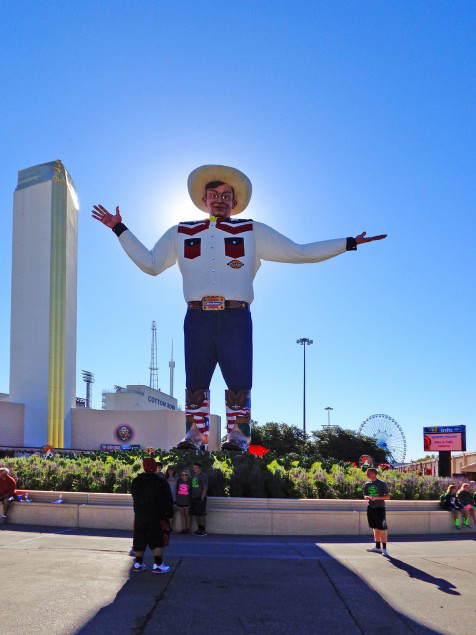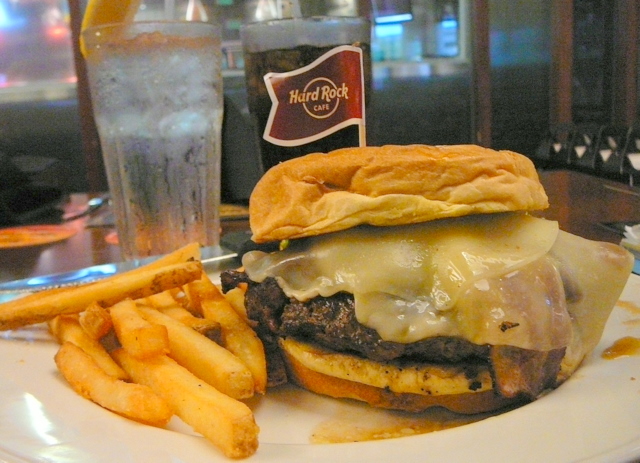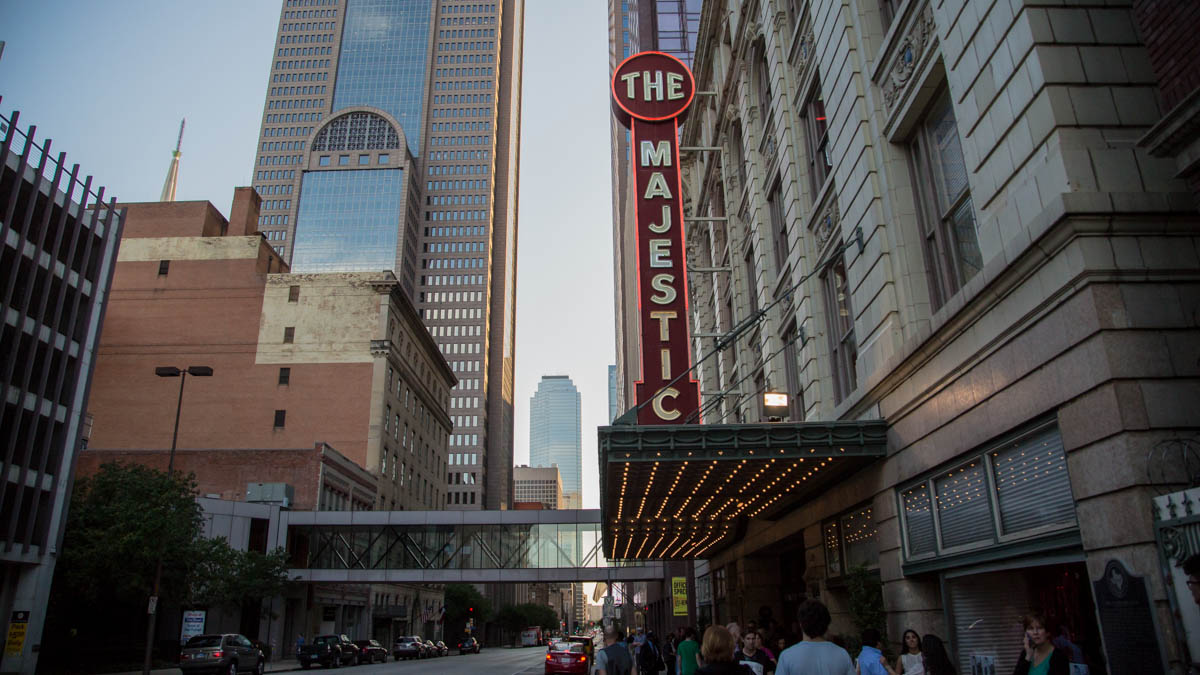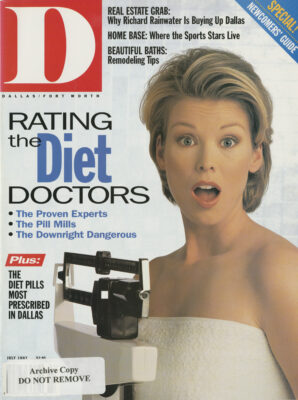1. THE FLYING RED HORSE.
Airline pilots can’t use Pegasus as a guiding light anymore, but it deserves to be listed first because of its pedigree. Erected in 1934 atop downtown’s Magnolia Building as a welcome to delegates to an oil convention, this was the focal point of the Dallas skyline until the 1950s, when it was corralled by the skyscrapers built around it. The sign consists of two horses, 8 feet apart; smart alecks in Fort Worth claim Dallas was trying to show we weren’t a one-horse town.
2. THE HOLE
This is the only icon among (he Top 40 scientifically classified as the absence of matter. The hole in the roof of Texas Stadium has been the subject of pre-kickoff chitchat since the stadium opened in 1971. TV cameramen cringe when long passes gleam across the screen in the bright sunlight then, at me last instant, disappear into the shadows.

3. THE BALL.
Opened in 1978, the geodesic dome atop Reunion Tower at the Hyatt has replaced the mythological equine as the city’s most recognizable symbol. The opening scene of the TV series “Dallas” elevated the Reunion ball to world-class icon status. It is 50 stories high, a 68-second elevator ride, or if you’re behind on your aerobics, 837 steps.
4. THE EGYPTIAN MYSTERY.
Campisi’s on Mockingbird Lane is a pizza shrine; it is not an Egyptian restaurant and never was. But cash was scarce when the Campisi family opened the establishment in 1950, so they kept the sign used by the former occupant.
Mickey Mantle once had clam sauce spilled in his lap here, and on “Lifestyles of the Rich and Famous,” Morgan Fairchild proclaimed Campisi’s her favorite restaurant in all the world.
5. THE TREE.
Every year since 1927, except during World War II and the energy crisis of 1973. the lighting of the tremendous pecan tree on Armstrong Parkway has been a Christmas tradition. More than 2,000 red, blue and green lights annually decorate the 130-year-old living landmark.

6. BIG TEX.
Originally a Santa Claus in Kerens, Texas, Big Tex has become the symbol of The Great State Fair of Texas. Fair officials bought him at (he bargain-basement price of $750 but have spent a lot more than that on 75-gallon hats, Jim Lowe, known as “the Cool Fool” to [he Dallas teenage radio audience of the 1950s, mouths the big guy’s greet-ing of “Howdy, Folks” to more than 3 million annual visitors.
7. NEARLY-AS-BIG TEX.
This neon cowboy was born to advertise the Big D Discount Store on North Central Expressway in the early ’50s. Centennial bought the 1,200 feet of neon tubing a few years later to adorn the liquor store on Lovers Lane at North Central, then when the DART spread moved in, old Nearly, declared a Dallas landmark in 1982, moseyed over to its present location at the Centennial store on Stemmons Freeway at Walnut Hill Lane.
8. THE GRASSY KNOLL
The term is a historical oddity coined by conspiracy theorist Mark Lane. When he interviewed witnesses to President John F. Kennedy’s assassination, one said she saw a suspicious character walking up the “grassy hill” and another thought she heard shots coming from the “knoll.” Lane preferred grassy knoll.
9. THE CATALOG.
Neiman Marcus traces its mail-order roots to a six-page brochure issued in 1915. By the 1950s, the catalog was an annual coffee-table essen-tial for the socially-conscious. Then m I960, to whet the appetites of the world press, Stanley Marcus came up with His and Hers Christinas gifts, which have included matching mummy cases, miniature submarines and hot-air balloons.
10. THE CONVERSION.

11. THE MEETING PUCE.
The Tom Thumb grocery store on Lovers Lane near Greenville Avenue in Old Town Shopping Center, having moved one lot over after relinquishing its spot to a huge Borders bookstore, has long been a favorite meeting place for singles who populate the sea of apartments in the area. One couple even had their wedding in the frozen food aisle at the old place.
12. THE “MEETING BACK AT’ PUCE.
North Park Center at Northwest Highway and North Central Expressway was opened in 1965 by Ray Nasher. and il has been hard to find a place 10 park there ever since. The main fountain at Dillard’s is the place of choice for professional shoppers to “meet back at” to discuss the hazards of impulse buying.
13. THE BARED MIDRIFF.
Little girls in Dallas don’t want to grow up to be Miss America; they want to he Dallas Cowboys Cheerleaders. The skimpily clad version of the rah-rah uniform originated in 1972 and became a national sensation at the 1976 Super Bowl, thanks to enthralled TV cameramen contemplating the navel.
14. THE PICTURE SHOW.

15. THE RANCH.
Although no one here would admit watching the kitschy saga of the Ewing chin on the TV series “Dallas.” nothing in the time slot came close to it in local viewer ratings. Southfork, just north of Piano, is undoubtedly the most famous ranch in the world and has attracted visitors from Cairo to Calcutta. Don’t forget your official Southfork belt buckle.
16. THE SODA FOUNTAIN.
Having dis-posed of such mundane matters as reporting on the best restaurant in France and the proper method for decanting wine in earlier issues. D Magazine in Mardi 1976 fumed to more serious topics by concluding that the best grilled cheese sandwich in Dallas could lie round al the Highland Park Pharmacy on Knox Street, which was celebrating its 63rd year in business. Nothing has changed, except now it’s the 84th year.
17. THE BIG UGLIES.
Perceptive new-comers will spot the winged monsters crouched and ready to spring on the unsuspecting from perches atop the roof of Old Red, our 105-year-old courthouse building. Years ago, one of the gargoyles lost its grip and fell to the ground; it was replaced by a fiberglass replica.
18. THE STRESSWAY.
North Central Expressway is fashioned in the image of the great god Stress. Built on the right-of-way of the first railroad to huff and puff its way into our fair city, the first 2-mile stretch of expressway opened in 1949, which, unfortunately, must have been before the invention of entry ramps. It has been either under construction, delayed by a stalled vehicle or otherwise encumbered since that time.
19. THE LAKE.

20. THE LONG NECK.
Our newest y icon, the 67-and-a-half-foot-tall giraffe standing guard at the entrance to the Dallas Zoo on Interstate 35E at Marsalis Avenue, is the tallest statue in Texas. When officials learned they were within a few inches of topping the statue of Sam Houston in Huntsville. the tongue, which might look bet-1er on an aardvark, was added to capture the top slot.
21. THE SCHOOL DESKS.
These are not for the three R’s; the old-fashioned writing desks at Sonny Bryan’s Smokehouse al 2202 Inwood Rd. are for the frenzied crowd lined up at lunch hour for the juicy sliced-beef sandwiches, greasy onion rings and cold draft beer that has made this place a heaven on Earth for barbecue lovers.
22. THE DALLAS PIECE.
This is the offi-cial name of the 27 tons of bronze-cast sculptures in front of City Hall at Akard and Young streets designed by British artist Henry Moore. Life is not easy in City Hall Plaza; periodically, a cleaning crew has to remove the graffiti, and worse.
23. THE WATERFALL
The 35-foot bill-board overlooking Stemmons Freeway near the Oak Lawn and Tollway exits that gushes a torrent of water onto artificial rocks extolled the merits of Pear! Beer when the spigot was opened 35 years ago. Since, It’s advertised Coors, Absolut and other products. On Texas-OU weekend, the sign has been known to gush red or orange.
24. WILD HORSES.
Robert Glen, a renowned sculptor of African wildlife, spent seven years producing the herd of nine bronze mustangs prancing through the stream at Williams Square on O’Connor Boulevard in the Las Colinas development in Irving. The sculpture is the perfect last-minute stop on the way to Dallas-Fort Worth Internationa! Airport to convince out-of-town visitors you know Texas stuff.
25. THE AROMA.
A pleasant diversion for those who happen to be parked on North Central in the vicinity of Mockingbird Lane is to inhale the irresistible aroma of fresh baked bread at Mrs. Baird’s Bakery. Tours are available; free samples, too.
26. SONNY THE STEER.
The white-faced steer who stands atop the Charco Broiler on Jefferson Boulevard in Oak Cliff rode into town on a traveling salesman’s flatbed truck in 1966. Sonny is the focal point of the evolution of this retail strip that is now the locale of a colorful accumulation of pawnbrokers, secondhand stores, eateries and assorted neighborhood shops.
27. PEANUTS.
Founded on a wing and a prayer. Southwest Airlines changed the lives of Dallas business commuters forever. The simple bag of peanuts is about all a harried passenger has time to scarf down before being herded out the door to make way for the next wave of passengers. You cannot get your Dallas citizenship papers until you experience Love Field on a Friday evening.
28. MOUNT VERNON.
When leg-endary oilman H.L. Hunt moved to Dallas in 1938, he bought this replica of George Washington’s place on the Potomac. Hunt, never one to come out second best in a trade, got the stately dwelling overlooking White Rock Lake, with land, furnishings and a pair of peacocks, for less than $70,000.
29. THE SHANTY.
The tew humble log cabin in the plaza in front of Old Red is symbolic of the habit of past generations of ignoring history. For years, Dallas school-children were taught that this was the actual cabin inhabited by the city’s founder, John Neely Bryan, but it has since been established that it belonged to a local ramier.
30. THE BALLROOM.
The bam-like dance hall on Cadiz at Industrial Boulevard started out as Bob Wills Ranch House featuring the granddaddy of west-em swing. Then Jack Ruby ran the operation, and the name was changed to Longhorn Ballroom. The diverse list of performers who have appeared here includes Ray Charles, the Zydeco HiRollers, Red Foley, B.B. King. Willie Nelson and the Sex Pistols.
31. BELT LINE.
The name does not denote the anatomical region of the body neglected by the munchers and gorgers along the Addison strip. In fact, the Addison area, although clearly the most noticeable stop on the route, is only a geographic blip on the irregular 96-mile loop around the county that meanders through Richardson. Garland, Mesquite, Cedar Hill, Irving, Coppell and points between.
32. THE SOUND OF THE BELLS.
Funded by a private interfaith foundation. Thanks-Giving Square-which, like Times Square, is actually a triangle-is a refreshing downtown oasis. A favorite feature is the 50-foot tower at the comer of Bryan Street and Pacific Avenue featuring three bronze bells that remind office workers when it’s time to go to lunch.
33. THE HERD.
Detractors claimed that the herd of bronze steers in Pioneer Plaza, one of the most popular attractions in the city, must have taken a wrong turn somewhere around Waco because they should be on the Chisholm Trail, which ran through Foil Worth. Now you know what they don’t-it was money from cattle barons like C.C. Slaughter and John Simpson that primed the pump that turned Dallas into a banking and financial center.
34. THE FILLING STATION.
When the Good Luck service station opened at the comer of Lamar and Cadiz streets in 1939, it was the epitome of the friendly tilling station where a motorist could gel his windows wiped, oil and water checked, and tires inflated without having to look for a Full Service sign. Bypassed by Stemmons Freeway and unoccupied, the old building clings precariously to life.
35. THE MANSION.
The elegant restaurant on Turtle Creek was once the home of Sheppard King, who made a fortune in the cotton market then roamed the Continent hand-picking Spanish tile, Italian marble and other accouterments for his residential palace. The hotel came later and has since become a pit stop for affluent international travelers. Margaret Thatcher, Frank Sinatra and King Olaf of Norway have slept here.
36. THE COFFEE SHOP SIGN.
One might wonder why the Pappadeaux Seafood Kitchen on Oak Lawn has a sign out front advertising Lucas B&B. From 1911 to 1989. this classic, all-night coffee shop was the place to wind down after a late show with a couple of hot waffles, a cup of Java and good-natured gaffing from irrepressible waitresses.
37. THE OLD SCOTSMAN’S HANGOUT.
The awkward-looking triangular building where Commerce and Wood streets intersect with North Central Expressway was once the home of radio station KL1F-AM (1190), whose founder, Gordon McLendon, saved radio from being destroyed by television in the 1950s by pioneering the Top 40 concept.
38. THE JAIL WHERE THE BEATLES STAYED.
The Decker Detention Center at 899 Stemmons Freeway was originally The Cabana, a luxury hotel financed by Doris Day and the Teamsters Union. Raquel Welch was one of the Greek Goddesses (cocktail waitresses), and the Beatles stayed here during their Dallas appearance in 1963. Dallas County converted the hotel to a jail facility named for ex-Sheriff Bill Decker.
39. THE BOWL.

40. THE HOUSE THAT BUD BUILT.
Refusing to concede to modesty, St. Louis beer baron Adolphus Busch, of Budweiser fame, built the grand hotel at the comer of Commerce and Akard streets in 1913, adorned it with a copper-capped turret in the form of a beer stein and named it for himself. The signatures of William Jennings Bryan, Teddy Roosevelt, Gen. John Pershing, Irving Berlin and Huey P. Long are on the guest register.






